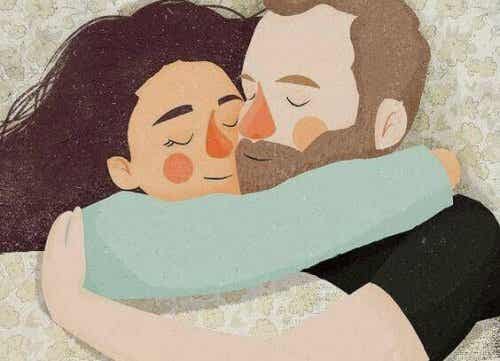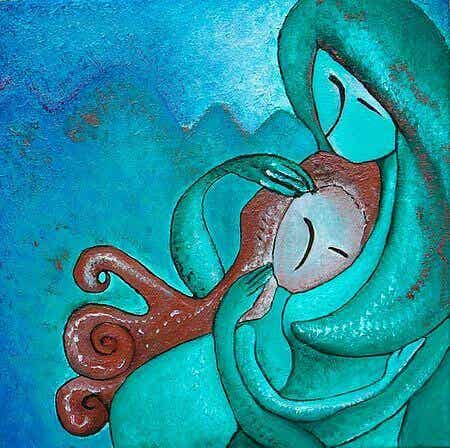
Written and verified by the psychologist GetPersonalGrowth.
Last update: 15 November 2021
Plato said that the body is the prison of the soul. Sometimes, in fact, instead of being our ally, he becomes the messenger of a disturbance. In the specific case we are dealing with today, that is the relationship between emotions and back, it is easy to say that our state of mind can generate contractures, tension and pain that drugs are not always able to relieve.
Back pain is one of the most common health ailments, along with headaches. It is estimated that 1 in 10 people suffer from it often and that it is, moreover, a leading cause of absence from work. On the other hand, and although this pain generally has the most disparate causes (bad ergonomics in the workplace, hernias, kidney problems, osteoporosis, arthritis, disc degeneration, etc.), there is an aspect that often goes unnoticed. .
We are talking about the relationship between mind and body. In particular, we refer to emotions and their impact on this extremely complex but fantastic combination of bones, ligaments, tendons, muscles, vertebral spaces, joints and nerves.. Factors such as stress or anxiety generate small changes in these structures that, little by little, result in inflammation, coordination problems and pain that greatly affect our quality of life.
Emotions and back
The relationship between emotions and the back is evident. Some experts do not hesitate to indicate the spine as the support not only of the weights we bear on a physical level, but also of those that concern the emotional level. The back is like the pillar of our existence, and we don't speak in spiritual or transcendental terms. It is enough to recall its structural function to our mind: to protect and enclose the delicate nervous system.
Lower back pain, contractures or, even worse, chronic back pain paralyze its functionality and force us to stop. Pain, after all, is like a faithful dog that watches on the doorstep and barks when it senses danger. Silencing it with drugs will do no good if we don't know about it cause, if we do not shed light on what is threatening the "pillar of our body", the balance of our physical existence.
Sadness, worry and stress
Strange as it may seem to us, back pain is often one of the most common physical symptoms in patients with depression or generalized anxiety. It is therefore more than common to see people turn to a myriad of physiotherapists and spine specialists without finding relief, without finding a remedy for this recurring pain that plagues their back. Until they are diagnosed by a psychologist or other mental health professional.
We cannot forget that pain is, above all else, a neurological experience transmitted by the nervous system. In these states characterized by anguish, fear, disappointment and despair, a chemical imbalance occurs. An irregularity between serotonin and norepinephrine generate, for example, an increase in the perception of pain.
In turn, these states of stress or anxiety result in an increased level of cortisol in the blood. This hormone increases blood flow, elevates muscle tension and it facilitates the emergence of certain autoimmune processes that can attack the joints, promote inflammation of the nerves and even reduce calcium in the bones.
Emotional pain and back pain
Swimming, anti-inflammatories, muscle relaxants… None of these remedies are useful when the person who has back pain is actually suffering from emotional pain. Just as explained in the Psychology Today magazine article, emotional suffering indicates that a part of our being is broken, fragmented. This invisible lesion is generally somatized in the form of back pain, headaches, digestive problems ...
At Duke University Medical Center, for example, we find professionals who are experienced in treating these kinds of conditions. Dr. Benson Hoffman explains that almost the80% of people suffer from lower back pain at least once in their lifetime. This is the most common disorder and it is useful to demonstrate the close relationship between emotions and back and, in concrete, that the emotional suffering associated with sadness or disappointment is localized in this area of the body.
Certainly a fascinating and revealing topic.
How to prevent and treat emotional back pain?
Let's try for a moment to visualize an image: ourselves with a quiver on our shoulders, a quiver full of arrows ready to destroy pain, to help us to support it better and to defend ourselves from what can attack us to turn into suffering.
- Biofeedback therapy (or biological feedback) it's a good way to get a well-equipped quiver. It is a practice with which the patient is taught to improve his health, acquiring greater awareness of aspects such as blood pressure, heart rate or muscle tension. It basically consists in training the brain to work in our favor, becoming aware of processes that we did not consider before.
- Cognitive-behavioral therapy in turn it stands as another more than appropriate framework for gaining greater control over our thoughts, managing emotions and fostering more appropriate and advantageous behaviors.
- From the American Association for the Study of Chronic Pain, they recommend strategies ranging from increasing the consumption of foods rich in vitamin B, to the point of making use of so-called distraction techniques, in other words training guided imagery, using aromas and even music to control pain.
At this point we are aware of the relationship between emotions and the back. We know that the mind has a direct link with the body and that the brain orchestrates this control, sometimes in a ruthless way, making any worries, anger or unresolved problems flow into the back, as if it were a particular torture chamber. We learn to prevent it, take care of our emotions as well as our nutrition and never forget to keep ourselves moving. A moving body and a mind capable of distraction are necessary for good health.


























